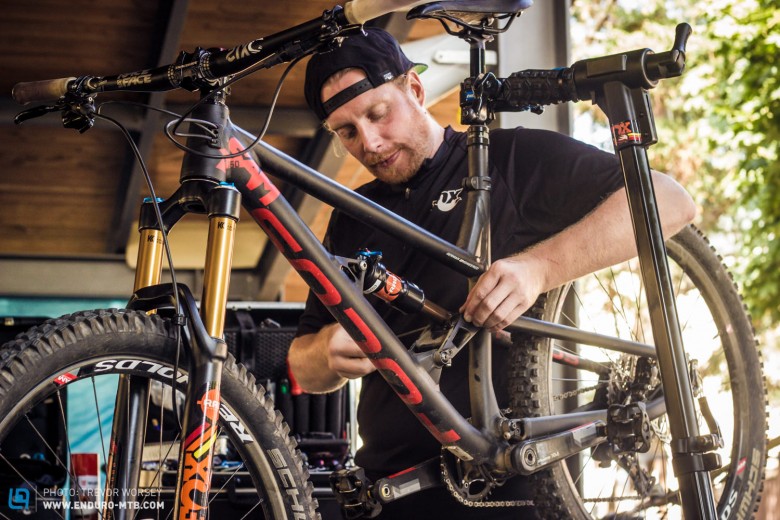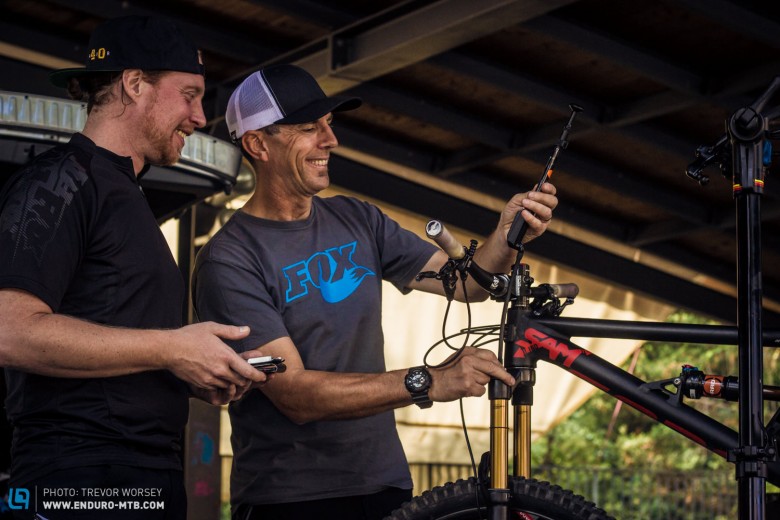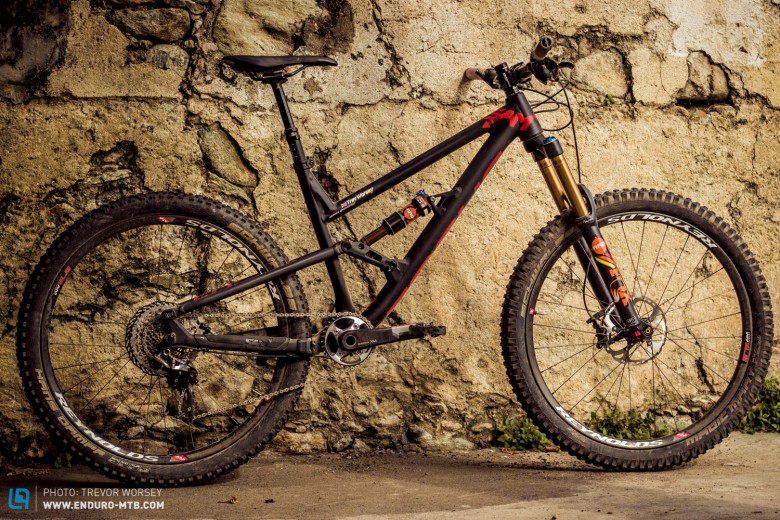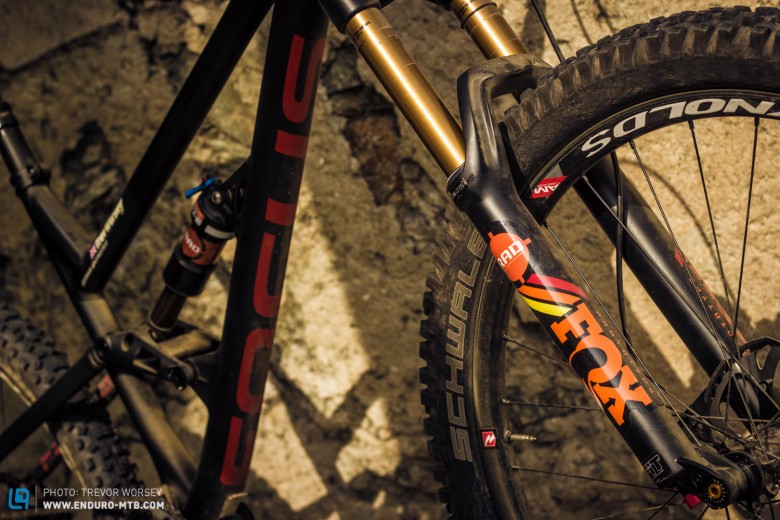On Location: FOX RAD Testing, a view of the future.

All morning Chris Trojer, FOX Europe’s main marketing man had been stressing that “this is an All Mountain set-up not a enduro race fork”, but as I found myself barreling through a high speed boulder strewn gully, fully committed to a crazy line, these shocks were going to have to be good, or I was probably going to hit the deck!
However, these were not your standard product launch shocks, we had been offered a very unique opportunity to spend a day in the FOX RAD program, usually only available to top athletes. We would be riding ‘one of a kind’ prototype FOX 34 fork and EVOL shock taken directly from the RAD testing program, full of un-patented technology, we were certainly not going to be allowed to have a peek inside. The RAD (Racing Application and Development) program follows the pathway of engineering, racing then finally the consumer, allowing FOX to show racers, journalists and consumers what they are working on, without committing to serial production.
This freedom allows the FOX engineers to incorporate and test new technologies, and if the design does not work, they can learn and move on. Not everything that the RAD team work on goes into production, 2 years ago at Mont Saint Anne, Gee Atherton practiced on an upside down RAD fork, but FOX were not happy with the stiffness to weight ratio, so instead focused their efforts on improving the Fox 40. For just one day we would be allowed to test out these unique shocks that may or may not have technology inside that will define the future range.



After the madness of the EWS had moved off, I met up with the FOX RAD team in a car park in Finale Ligure where we were going to be running shuttle runs to test out the prototype shocks. I had brought my long term Focus SAM 1.0 and before we switched to the new shocks we wanted to do a few runs on our existing setup as a bench mark. The team had chosen to test on Stage 5 of the 2014 Enduro World Series, a high speed and rough stage with big slabs, rock features and a lot of technical passages, these RAD forks were going to get a beating. So after a couple of hot and full on runs, we had our lines down and were keen to see what improvements the Fox engineers had been working on.



Today we were testing the new RAD 34 forks, although using the same chassis as the current fork they had both a prototype damper and a prototype air sack inside. The fork still uses a three position compression system, and on the air side it uses a prototype form of a compression system that has already been introduced on the 36, and a prototype FIT damper on the other side. The internals are completely custom, the negative spring has been removed to save weight and the fork now gives consistent travel regardless of rider weight and air pressure, if you buy a 160mm fork, you will get 160mm of travel. The fork I was riding also had a fine tune compression adjustment for open mode, and a fast recovery system to keep the fork up in its travel.



The rear shock we were testing was the new EVOL shock, with a bigger air chamber on the negative side. This shock incorporates developments from the snowmobile world and is a development of the shock that was ridden by Martin Maes last season. The shock features a bigger negative air chamber to increase initial sensitivity, and improve small bump compliance. The damper is a new design, with a new philosophy, and is targeted at a XC and AM rider who is looking for a strong pedal platform, with a three position compression adjuster with a further three positions in the fully open mode.


The Ride
I used to be an avid FOX fan, but if I am honest I personally thought that the 2013 Fox 34 was a terrible fork, a fork that dived like crazy at exactly the times that you needed it, leaving many racers no choice but to overfill the oil chambers in an attempt to tame the beast. At that point I moved to other brands for my personal suspension, but FOX picked up the pieces and came back swinging in 2014 with massive improvements to their entire range, and on the starting grid of the Finale EWS I had never seen such a jump back to the new Fox 36’s. So as I rolled around the car park on the RAD units I was initially a little concerned, the forks and shock were so smooth and active that surely we were going to see them overwhelemed by the choppy trails. Chris and Ty spent plenty of time getting the setup just right, perfect sag (25% on the forks and 30% on the shock) and with a few clicks of low speed compression and a little rebound I was ready to go.

I have always found that the measure of good suspension is that you simply do not notice it doing its job, absorbing bumps and compressions while you focus on the riding. Suspension setup is also reflected in the way that I ride a bike, when the suspension is under performing, whether it be diving, or too harsh I am very conscious of ‘steering’ the bike through rough terrain. When the suspension is balanced and working in harmony I use my body a lot more to lean and carve the bike over the rocks, free to focus more on lines and having fun, while the shocks take the beating and smooth the transition between ‘hero’ and ‘just plain stupid’ lines.

What was immediately apparent from the RAD units was how much more active they are, the larger negative air chamber is obviously doing its job, as at high speeds the shocks responded with almost coil like sensitivity in the first quarter of the stroke. Small bumps and chatter were smoothed out very effectively and there was little buzz from the trail as the speeds picked up. My initial concerns about blowing through the travel were unfounded as both the fork and shock had a very quick recovery, running high in their travel and offering progressive support. The trail featured lots of big G-out compressions so I added a few more clicks of low speed to keep things under control, I also added two extra clicks of rebound damping to help the bike hold better in the sandy corners and ended up with a really sweet setup.
OK, these forks are aimed at the AM rider and we were hitting full on Enduro race stages, so they did not have quite the stiffness of a 36 chassis, but the damping was very impressive indeed and the level of control was superb. The RAD 34 and EVOL worked in complete harmony and the bike felt amazingly composed and balanced through the rock gullies, it felt like I was running a much bigger fork and coil, yet the lightweight setup was still super efficient to pedal and sprint.

At the end of the session, I had been really impressed with the high performance of the shocks, so much so that I was very sad to see them get taken off and go back into the ‘secret’ box. I am sure we will start to see this technology filter down into the production range soon and when it does FOX is sure to have some popular products on their hands.

Words: Trev Worsey Photos: Trev Worsey and Chris Trojer
Did you enjoy this article? If so, we would be stoked if you decide to support us with a monthly contribution. By becoming a supporter of ENDURO, you will help secure a sustainable future for high-quality mountain bike journalism. Click here to learn more.







